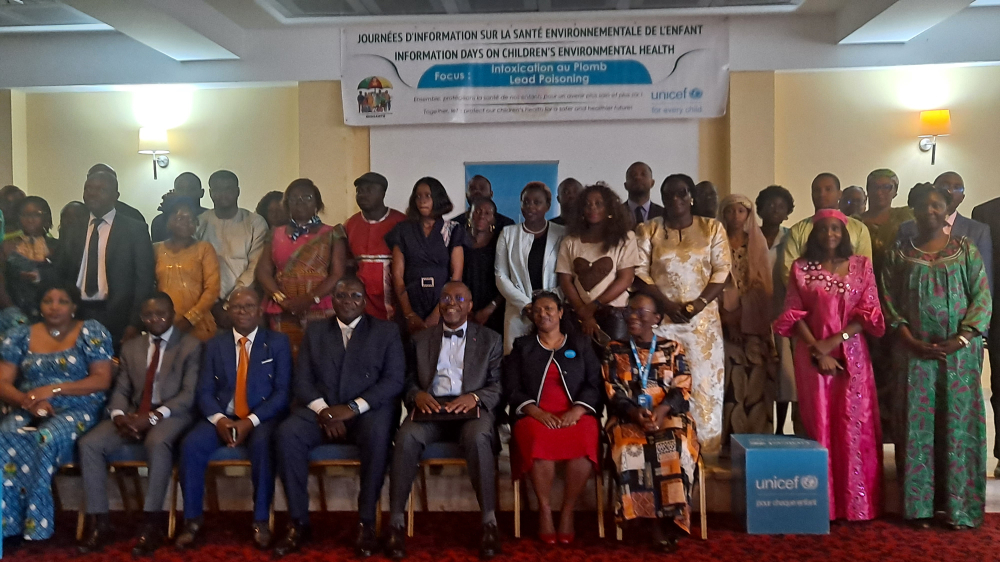Environmental Health : As Lead Poisoning Stalks Children, Pregnant Women
- Par Kimeng Hilton
- 09 juil. 2025 17:02
- 0 Likes

The Ministry of Public Health and the United Nations Children’s Fund, UNICEF are organizing a three-day workshop on the topic.
The workshop, which is attended by representatives of several government ministries, opened on July 9, 2025 in Yaounde. Organisers described lead poisoning as “a major public health challenge” the world over. According to Sharmila Pillai, UNICEF Cameroon Acting Deputy Country Representative, environmental health is a right, not a luxury. She said over five million children below five die of environmental health challenges the world over.
Social Justice Matter
“Lead is a toxic metal that undermines children’s health and education,” Sharmila emphasized. “Lead poisoning is not only a public health challenge, but more especially a social justice matter,” she added. Pillai promised UNICEF will include environmental health in its 2026-2030 Cameroon Country Programme.
Sources Of Lead Poisoning
She said lead poisoning results from recycling of batteries, paint and pollution generally of the environment. “We will work with government and partners to reach the most number of children by passing down information, research findings and capacity building,” Sharmila promised. Dr Ngum Belyse Halmata, Health Specialist with UNICEF Cameroon, said lead poisoning occurs through water, skin, food (vegetables and fruits), affecting children less than five and pregnant women. Lead poisoning is a silent killer that needs to be tackled, Dr Ngum underscored.
Multi-stakeholder Action
The Permanent Secretary in the Ministry of Public Health, Prof. Louis Richard Njock warned of the consequences of lead poisoning in children, saying awareness-raising on lead poisoning and its risks must take centre stage in public health actions. He agreed with UNICEF that the fight against lead poisoning requires multi-stakeholder action.
Investment In The Future
“Protecting children from environmental risks such as lead exposure means guaranteeing their fundamental right to grow up healthy, to learn, and to thrive… Every prevention action today is an investment in the future of Cameroon,” Nadine Perrault, UNICEF Cameroon Country Representative, said in statement. “The Ministry of Public Health, in collaboration with UNICEF, thus reaffirms its commitment to strengthening national capacities and supporting prevention policies to ensure a healthy environment for every child in Cameroon,” Perrault noted.
Challenges With Enforcement
A 2022-2023 study carried out in Maga Subdivision, Mayo Danay Division of the Far North Region revealed that the levels of lead in rice grains, soil and water were well above the minimum standard set by the Food and Agricultural Organisation, FAO. In Cameroon, tackling the problem has met with some hiccups - such as lapses in implementing regulations, the high socio-economic cost of treatment, the need for better diagnosis of the problem and a multi-stakeholder approach.
Baseline Data
“An initial study will be carried out to come up with baseline data, to add to what already exists in order to have a better situation of food poisoning in the country,” Dr Ngum disclosed. She said the training includes 12 modules – introduction to environmental health, poisoning by different metals (lead, mercury…), pesticides and air pollution, climate change…. “For now, we cannot say which regions in the country are most affected by lead poisoning until we carry out a comprehensive survey,” Dr. Ngum explained.
Wide Exposure
The workshop aimed to raise awareness among decision-makers and key stakeholders in health and the environment about the harmful effects of lead exposure on the health of children and pregnant women. This, in a context marked by increasing urbanization, informal industrial activities, and inadequate management of toxic waste. According to UNICEF, more than one in three children worldwide is exposed to dangerous levels of lead from water, soil, air, or food. Cameroon is not far behind, as evidenced by a study by CREPD (Centre for Research and Education for Development) conducted in Douala, which revealed extremely high levels of lead in the soil near battery recycling sites.
Workshop Activities
Participants were briefed on the latest data on the situation in Cameroon, the pathways of lead exposure, its effects on child development, and the risks for pregnant women. A presentation of the e-learning module developed by UNICEF on child environmental health was also presented, followed by a live demonstration to facilitate access to the AGORA platform. The first day paved the way for two days of online certification training. Which is scheduled for July 10-11, 2025, in UNICEF Cameroon, for technicians and professionals in the health, environment, and child protection sectors.
Background, Rationale
According to UNICEF (2025), the considerable progress made in child survival over the past 30 years is threatened by climate change and environmental degradation. Child morbidity patterns are evolving, and children face multiple and overlapping risks due to climate change, air pollution, exposure to toxic chemicals and waste. Others are unsafe built environments, antimicrobial resistance, extreme heat, air pollution, lead poisoning, and more. More than one in three children worldwide is exposed to dangerous levels of lead from air, water, soil, and food. Lead is an extremely harmful metal, particularly for young children. WHO (2019) ranks it among the 10 most toxic chemicals.
Douala Study
In Cameroon, lead contamination from battery recycling and other industrial and mining activities has attracted public and policymaker attention in recent years. One of the main sources of lead contamination is undoubtedly battery recycling. Lead-acid battery recycling in Cameroon is poorly regulated. A 2017 CREPD study of three recycling plants in Douala revealed significant soil contamination inside the plants and in nearby residential areas.
The average lead concentration in soil samples was 22,952 ppm (2.2%), with indoor levels reaching up to 76,000 ppm (7.6%). Outside the plants, soil lead levels ranged from 17,000 ppm to 150,000 ppm (1.7% to 15%). Indeed, on September 21, 2017, Cameroon became the first African country to regulate lead levels in paints in accordance with the international standard of 90 ppm promoted by the Global Alliance to Eliminate Lead Paint, co-led by the United Nations Environment Programme (UNEP) and the World Health Organization (WHO).
Causative Factors
In Cameroon, several factors suggest a significant risk of lead exposure. They are artisanal a...
Cet article complet est réservé aux abonnés
Déjà abonné ? Identifiez-vous >
Accédez en illimité à Cameroon Tribune Digital à partir de 26250 FCFA
Je M'abonne1 minute suffit pour vous abonner à Cameroon Tribune Digital !
- Votre numéro spécial cameroon-tribune en version numérique
- Des encarts
- Des appels d'offres exclusives
- D'avant-première (accès 24h avant la publication)
- Des éditions consultables sur tous supports (smartphone, tablettes, PC)














Commentaires